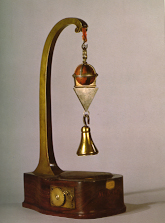
41.5 x 16.2 x 23
Wood, brass, steel, silver and leather
INDEX 1788 : M.IV.44
Magnes alter figurae sphaericae, diametro linearum 17, pondere unciarum 7. Hic armatus est laminis chalybeis, quae ope quarundam zonarum ex Argento cum Magnete arcte conjunguntur. Sustulit pondus unciarum 170. Suspenditur a columna ex orichalco, super basim ligneam stabili.
Another spherical magnet, linear diameter of 17, with a 7 ounce weight. This has thin steel bands which, together with some strips of silver, combine to fit round the magnet. It can hold a weight of 170 ounces. It is suspended from a solid brass shaft on a wooden base.
This magnet consists of a spherical piece of lodestone, with a black band separating the north and south hemispheres, which are painted red. Touching each hemisphere is a polar piece. The letter N is engraved on one, the other is unmarked. They are suspending a triangular piece of steel, attracted by the magnet. Different weights can be suspended from the lower vertice of the triangle to determine the breaking force of the magnet.
The lodestone sphere is encased by silver strips which meet in a point at the top, that extends to form the ring by which it is suspended. It hangs from a ribbon that passes inside the brass stand. The stand is mounted on a wooden base which has a toothed wheel on one side. This wheel is joined to an axle in the base, on the opposite side. A handle is attached to the axle which, when rotated, turns the wheel and raises or lowers the magnet. The wheel has a tongue which acts as a brake when it is not being turned, keeping the magnet suspended.
There is a cushion on the base to absorb the impact of the body suspended by the magnet when the breaking force is reached.
The following inscription appears on the brass stand: "Gul.mus Dugood F. R. S. Paranit Lisboneae MDCCLI". The magnet was thus mounted in 1751 by the Englishman William Dugood, who also mounted the Chinese Magnet (instrument 110).
From Colégio dos Nobres, catalogue n.º 41.Dalla Bella, Giovanvanni Antonio, Physices Elementa, Coimbra, 1790, Vol. III, Pl. VI, Fig. 22.